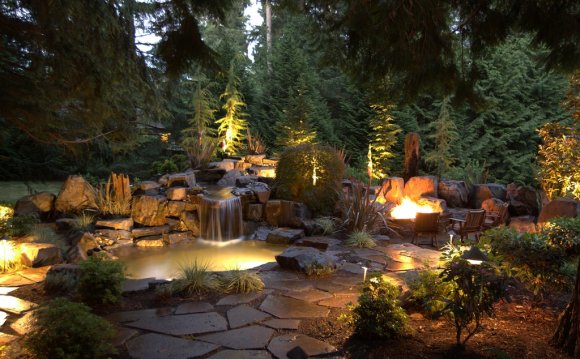
 Rustic Landscape Style Guide
Rustic Landscape Style Guide
Use this design sheet to help you create the perfect rustic landscape. You'll get ideas for color, décor, materials, plants and fabric. It is a great starting point for any country landscaping project.
Rustic Landscape Style Guide (PDF)
Plants for a Rustic Garden
Plants for a woodland Pacific Northwest garden:
Common native elderberry
Black Beauty elderberry
Madonna elderberry
Black Lace elderberry
Native ninebark
Coppertina ninebark
Center glow ninebark
Diabolo ninebark
Vine maple
Ferns
Plants for a rustic meadow-like setting:
Ox-eye daisy
Echinacea Big Sky series
Rudbeckia nitida
Moudry fountain grass
Morning Light maiden grass
Penstemon
Whether you're in a woodland setting or out on the prairie, rustic landscape design is all about reflecting the natural surroundings.
Yet even though a rustic style calls for a naturalistic look, "good design is just as important as in a more formal setting, ' says landscape designer Christine Ellis. Ellis has been practicing since 1995, and she makes the point that a serene and calming environment doesn't happen by chance. Here are her professional tips for creating a rustic garden retreat.
Dos:
- Do think about how you want to use the space. "Do you want to sit around the fire and tell ghost stories? Or create a quiet area for contemplation?" asks Ellis. The design should stem from the practical ways in which you want to use the landscape.
- Do create undulations in the lawn and garden beds. The gently rolling look evokes a meadow setting, but beyond that, it catches rainfall and becomes a long-lasting source of moisture for the plants. "With this strategy, " Ellis says, "you may not need to begin watering the garden until June."
- Do let the moss grow. In a rustic forested area, moss gives a timeless feel to the stone and pathways and can be a beautiful addition to the landscape.
- Do use pathways to influence mood. A wide pathway invites a speedy pace and is well-suited to the entry, but as you walk through the garden, let your pathway narrow to invite contemplation. As you slow down to walk a narrow path, "your feelings transform from outward to inward, " says Ellis.
Don'ts:
- Don't fight nature. In a rustic setting, there's room for a bit of serendipity. "Let the English daisies, flowering yarrow, and dandelions come up in the lawn, " says Ellis. "Mow them down before they set seed, but don't let perfectionism keep you from enjoying the flowers while they last."
- Don't pull out your hedging shears. The rustic style reflects nature, and there are few crisp, cut, trimmed edges in nature. Instead, opt to prune shrubs and trees by hand to make the most of each plant's natural habit.
- Don't shy away from picking out your own décor and garden features. "Trust your judgment, " advises Ellis. Gardens are a place to express your personality and have fun, and "if you don't like something you've chosen, you can always change it, " she says.
- Don't go for generic plants that can be found everywhere. Instead, use your region's natives as a starting point to create your own unique palette. In the Northwest, Ellis might choose local elderberry as a starting point, then mix it up by adding elderberries that have colored foliage or a lacier texture.
Even when designing for a certain setting, such as rustic or woodland, it's a good idea to keep an open mind about how your space and your own personality might inform the landscaping. Gregg & Ellis bring that same spirit to each of their projects. "We don't start with any preconceived notions about what the garden should look like, " she says. "We bring our knowledge and sense of design, and develop personal solutions for each client and site."
YOU MIGHT ALSO LIKE











